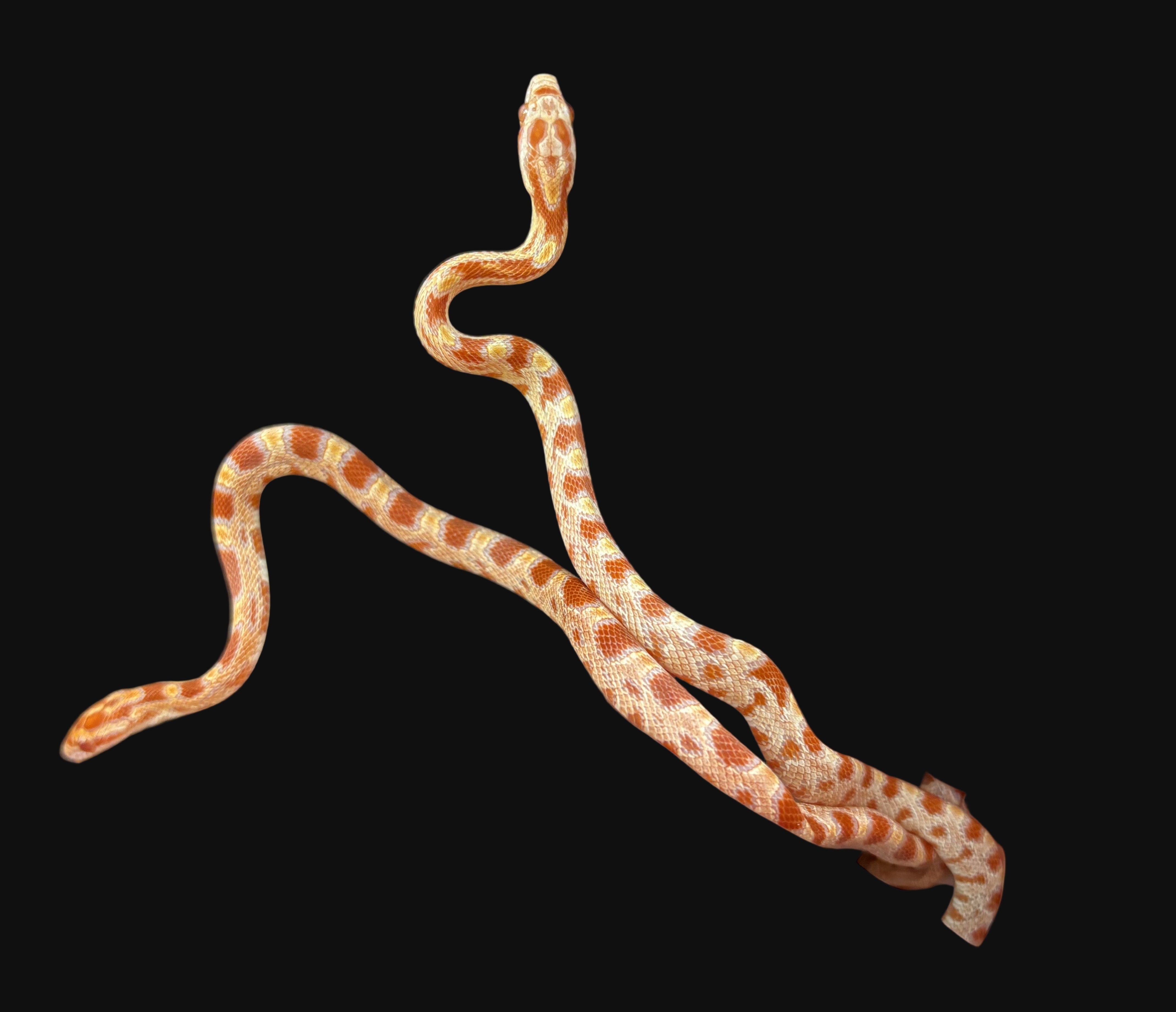Photo Disclaimer
Description
Corn Snake (Reverse Okeetee)
Scientific Name: Pantherophis guttatus
Common Name: Corn Snake
Species Overview
Size: Adults typically reach 3–5 feet (0.9–1.5 m) in length, with a slender, muscular body and smooth, glossy scales.
Appearance: The Reverse Okeetee Corn Snake is a vivid, high-contrast variation that flips the coloration of the traditional Okeetee through the influence of the Amelanistic (Albino) gene. This Corn Snake displays bright red to deep orange dorsal saddles bordered in crisp white over a golden-yellow to pale orange background. The clean white saddle borders are the hallmark of this morph, mimicking the thick black edging of a normal Okeetee but in reversed pigmentation. The Okeetee lineage emphasizes contrast and saturation, producing exceptionally rich color and sharp pattern definition. The eyes are ruby red, a typical trait of amelanistic Corn Snakes, complementing their fiery appearance.
Distribution: A selectively bred morph of the Corn Snake (P. guttatus), developed by combining the Amelanistic recessive gene with Okeetee lineage traits.
Habitat: Wild Corn Snakes are native to the southeastern United States, inhabiting forests, farmlands, and grasslands. In captivity, Reverse Okeetee Corn Snakes thrive in naturalistic enclosures with climbing opportunities, ground cover, and secure hiding spaces.
Behaviour: Corn Snakes are crepuscular, most active during dawn and dusk. They are hardy, adaptable, and consistent feeders, performing well in both display setups and breeding collections.
Captive Care
Enclosure: A naturalistic 40-gallon terrarium (36” × 18” × 18”) or larger is ideal for adults. A soil-based or bioactive substrate layered with leaf litter encourages natural burrowing and exploration. Include multiple hides, cork flats, climbing branches, and plant cover for enrichment and security.
Temperature & Humidity: Maintain a daytime gradient of 75–82°F (24–28°C) with a basking area of 86–88°F (30–31°C). Allow nighttime drops to 70°F (21°C). Keep humidity between 40–60%, offering a humid hide during shedding.
Diet: Offer frozen-thawed rodents every 7–10 days for juveniles and every 10–14 days for adults. Prey should be approximately 1.25× the width of the snake’s mid-body.
Behaviour in Captivity: Corn Snakes are active, exploratory, and well-suited to naturalistic terrariums. They thrive with consistent environmental conditions and regular feeding routines.
Special Considerations: Selective breeding of Reverse Okeetee lines can produce animals with exceptionally thick white borders and deeper red tones. This morph pairs beautifully with traits such as Scaleless or Hypo to create striking high-contrast combinations.
Genetics Note
Amelanistic (Recessive)
Removes black pigment, producing bright red, orange, and yellow coloration with red eyes.
Okeetee Line (Selective Line Trait)
A selectively bred lineage emphasizing strong color contrast and thick saddle borders. This is a polygenic trait based on selective breeding rather than a single-gene mutation.
Genetic Combination Summary
The Reverse Okeetee Corn Snake expresses one recessive and one polygenic trait:
-
Amelanistic = Removes black pigment, producing vivid red and orange tones with white borders
-
Okeetee Line = Enhances border definition and amplifies color contrast
Together, these traits produce a bright, high-contrast snake with fiery reds and clean white borders. The Reverse Okeetee Corn Snake remains one of the most visually recognizable and widely admired morphs—an essential lineage in modern Corn Snake breeding for those seeking intense color and crisp patterning.

